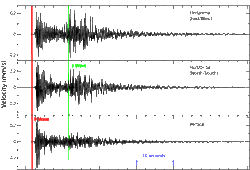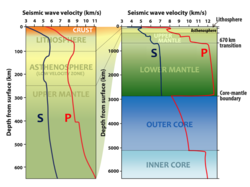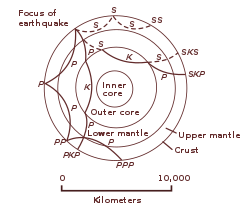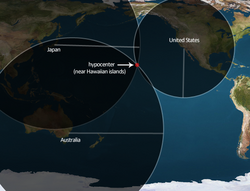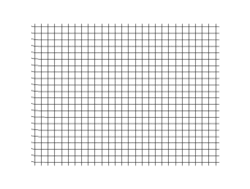Seismic wave
Seismic waves are vibrating movement of the ground. Seismic waves can be caused by underground explosions, volcanic eruptions and man-made explosions that can vibrate the ground. Seismic waves go through the Earth’s layers. The speed of seismic waves depends on the type of materials they meet. When they meet different kind of material, they bounce or go in different directions. Seismic waves can be detected by seismographs.
Causes
Seismic waves are caused by earthquakes, underground explosions, volcanic eruptions and man-made explosions that can vibrate the ground. When earthquakes occur, they release energy in a form of seismic waves. Seismic waves make the ground vibrating to all directions from the starting point of the earthquake.[1][2][3]
Types
Seismic waves are divided into two main types of waves, body waves and surface waves. Body waves go through the Earth, and surface waves go along the Earth’s surface.[1][2][3][4]:40
Body Waves
Body waves travel through the Earth’s interior. Body waves are divided into two types, primary waves and secondary waves.[1][2][3][4]:7
Primary Waves (P-waves)
Primary waves travel faster than any other waves, so when earthquakes occur primary waves arrive first at the surface. That’s why we call them ‘primary’.[1][2][3][4]:13 Primary waves can go through solids, liquids and gases.[1][2][4]:36 Primary waves go 7~8 kilometers per second in solids, but primary waves have different speeds in liquids and gases.[2][3] The ground moves back and forth in the same direction as the primary waves move. Primary waves repeat squeezing and stretching the ground when they move.[1][2][3][4]:13[5]
Secondary Waves (S-waves)
Secondary waves arrive after primary waves. That’s why we call them ‘secondary’.[1][2][3] Secondary waves can go 3~4 kilometers per second. Secondary waves can’t go through air and liquids. They can only go through solids.[1][2][4]:43 The ground moves up and down in the right angle to the direction of the secondary waves.[1][2][3] Secondary waves temporary change the shape of materials.[1][2][3]
Surface Waves
Surface waves travel along the Earth’s surface. They come after the body waves.[1][2][3][4]:43 Surface waves are caused by primary waves and secondary waves when they arrive at the surface.[2][4]:43 There are two types of surface waves.[1][2][4]:43
Rayleigh Waves
Rayleigh waves were named after John William Strutt Rayleigh. When Raleigh waves travel, the particles move in an oval shape, similar to water waves. The speed of Rayleigh waves depends on the types of solids. Information about Rayleigh waves give us the reason why the ground vibrates. Rayleigh waves are slower than Love waves.[1][4]:37
Love Waves
Love waves were named after A.E.H. Love.[4]:28 Particles move back and forth at a 90 degree angle to the wave direction.[4]:37 The speed of Love waves depends on the types of solids.[1][2] We can know the thickness of the Earth’s crust with Love waves. Love waves usually travel faster than the Rayleigh waves.[1][4]:28
Detection
Seismic waves can be detected and recorded by seismographs.[1][3][4]:40-41 Primary waves are recorded faster than secondary waves.[1][2][3][4]:40-41 The period between the arrival time of primary waves and secondary waves is used to find the starting point of the wave.[2][3][4]:40-41[6] We can know about the Earth’s layer through seismic waves.[3]
Seismic Wave Media
Cross section of the whole Earth, showing the complexity of paths of earthquake waves. The paths curve because the different rock types found at different depths change the speed at which the waves travel. Solid lines marked P are compressional waves; dashed lines marked S are shear waves. S waves do not travel through the core but may be converted to compressional waves (marked K) on entering the core (PKP,
The hypocenter/epicenter of an earthquake is calculated by using the seismic data of that earthquake from at least three different locations. The hypocenter/epicenter is found at the intersection of three circles centered on three observation stations, here shown in Japan, Australia and the United States. The radius of each circle is calculated from the difference in the arrival times of P- and S-waves at the corresponding station.
References
- ↑ 1.00 1.01 1.02 1.03 1.04 1.05 1.06 1.07 1.08 1.09 1.10 1.11 1.12 1.13 1.14 1.15 1.16 David G. Smith ed., The Cambridge Encyclopedia of Earth Sciences (New York, NY: Cambridge University Press, 1982), 36-39
- ↑ 2.00 2.01 2.02 2.03 2.04 2.05 2.06 2.07 2.08 2.09 2.10 2.11 2.12 2.13 2.14 2.15 2.16 Steven I. Dutch, James S. Monroe and Joseph M. Moran, Earth Science (Belmont, CA: Wadsworth Publishing Company, 1998), 167-168
- ↑ 3.00 3.01 3.02 3.03 3.04 3.05 3.06 3.07 3.08 3.09 3.10 3.11 3.12 3.13 Frederick K. Lutgens and Edward J. Tarbuck, Essentials of Geology (Upper Saddle River, NJ: Prentice Hall, 2000), 295-298
- ↑ 4.00 4.01 4.02 4.03 4.04 4.05 4.06 4.07 4.08 4.09 4.10 4.11 4.12 4.13 4.14 4.15 Brian J. Knapp, Visual Science Encyclopedia; Earthquakes and Volcanoes (Denbury, CT: Grolier Educational, 2002)
- ↑ Margaret Carruthers The Young Oxford Library of Science Volume 3; Land, Sea and Air (New York, NY: Oxford University Press, 2002), 19
- ↑ Jan Anderson, et al, The Grolier Encyclopedia of Science and Technology (Denbury, CT: Grolier educational, 1993)

